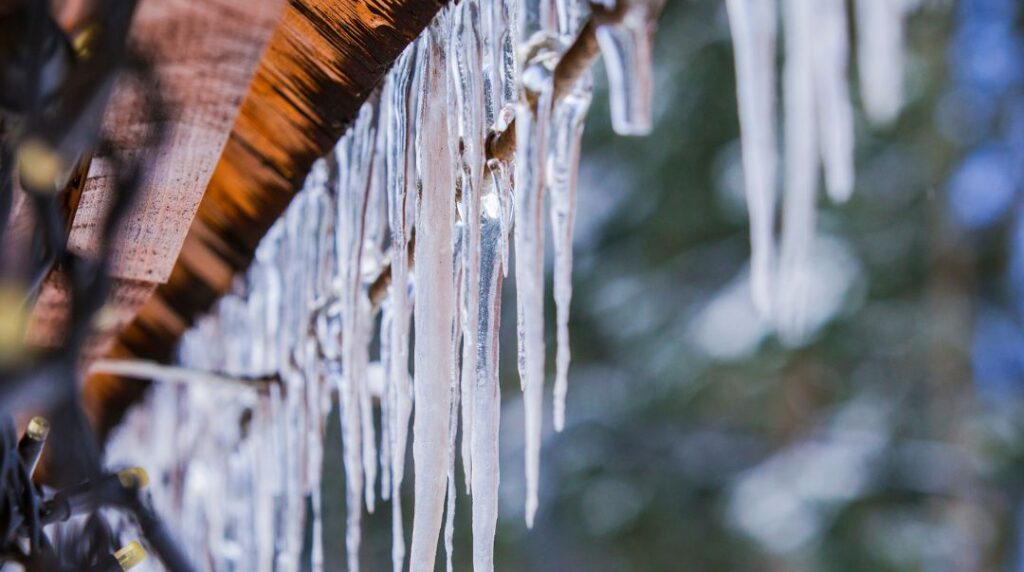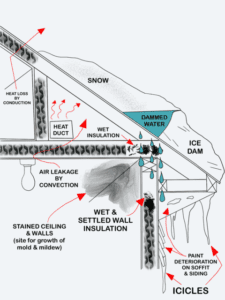
Ice Dams 101: What Every Homeowner Needs to Know
Winter transforms neighborhoods into picturesque wonderlands, but with this beauty comes hidden dangers. Ice dams, often unnoticed, can wreak havoc on your home. Understanding ice dams is crucial for homeowners in cold climates to protect their investments.
Key Takeaways
- Ice dams form when snow melts and refreezes at the roof's edge.
- They can cause water to seep into your home, leading to costly damage.
- Proper attic insulation and ventilation are key to preventing ice dams.
- Regular roof maintenance and snow removal are essential.
- Professional help from Becker Exteriors may be necessary for severe ice dams or damage.
What are Ice Dams?
Ice dams occur when snow on your roof melts—often due to heat escaping from your attic—and refreezes at the edge. This creates a barrier that prevents water from properly draining off the roof. As water backs up behind the dam, it can seep into your home, causing damage to ceilings, walls, and insulation.
Ice dams are common in regions with freezing temperatures and heavy snowfall. Poor insulation and ventilation exacerbate the problem by allowing attic heat to warm the roof, triggering the melting and refreezing cycle. Understanding how they form is the first step in prevention.
Risks of Ice Dams
Ice dams pose significant risks:
- Water Damage: Water backing up can seep into walls, ceilings, and insulation, leading to costly repairs.
- Mold Growth: Persistent moisture creates an environment conducive to mold, which can harm your home’s structure and your family’s health.
- Structural Issues: Continuous water infiltration weakens building materials, while the ice’s weight stresses your roof.
- Energy Loss: Water damage to insulation increases heat loss, raising energy bills.
If you suspect any of these issues, call Becker Exteriors at 816-500-1182 to assess your roof and provide a tailored solution.
How to Identify Ice Dams
Early detection can save you money. Watch for these signs:
- Icicles: Large icicles along the roof’s edge or gutters often indicate an ice dam.
- Water Stains: Damp spots or discoloration on ceilings signal potential water leakage.
- Ice Buildup: Check for ice accumulation along the roof’s edge after heavy snowfall.
- Moisture in the Attic: Frost or moisture inside the attic suggests heat is escaping and melting snow on the roof.
If you notice any of these warning signs, Becker Exteriors is just a call away to inspect and resolve the issue before it worsens.
Preventing Ice Dams
- Insulation and Ventilation—Proper attic insulation and ventilation are critical. Insulation prevents heat from escaping, while ventilation keeps the roof’s temperature consistent. Ensure soffit and ridge vents allow adequate airflow.
- Seal Air Leaks—Close gaps around plumbing vents, chimneys, and other openings to stop warm air from escaping into the attic.
- Snow Removal—Use a roof rake to clear snow from your roof after heavy snowfall. This minimizes the amount of snow that can melt and refreeze.
- Install Heating Cables—Heating cables along the roof’s edge prevent ice formation by keeping the area warm. Though an investment, they offer effective protection.
- Gutter Maintenance—Clear gutters regularly to ensure proper drainage. Clogged gutters can contribute to ice buildup.
Becker Exteriors can assist with professional insulation upgrades, ventilation improvements, and gutter maintenance to help prevent ice dams from forming.
Protecting Your Roof
- Inspect Your Roof: Regularly check for damaged shingles or loose flashing and repair them before winter.
- Trim Overhanging Branches: Sunlight helps melt snow evenly, reducing the risk of ice dams.
- Waterproof Membranes: Install these under shingles as an extra barrier against water intrusion.
- Gutter Guards: Prevent debris buildup, ensuring proper water flow and reducing ice dam risks.
Let Becker Exteriors handle these critical tasks for you, ensuring your roof is ready to withstand winter challenges.
When to Call Professionals
Despite preventative efforts, ice dams can still form. Here’s when to seek help:
- Roof Damage: Roofers can assess and repair damage caused by ice dams.
- Insulation Issues: Experts can recommend and install effective insulation solutions.
- Snow Removal: Professional services can safely clear heavy snow without damaging your roof.
- Mold Remediation: Specialists can address water damage and mold growth.
Becker Exteriors offers comprehensive solutions to identify, repair, and prevent leaks caused by ice dams. They also provide snow removal services for vulnerable areas of your roof. Contact Becker Exteriors at 816-500-1182 for a free estimate. Locally owned and operated, they’re ready to keep your home safe this winter.
Frequently Asked Questions
What do ice dams do? Ice dams form when snow melts and refreezes at the edges of a roof, preventing proper drainage. This leads to water backing up and leaking into your home.
How do you get rid of an ice dam? Safely remove snow with a roof rake or hire a professional. Ice melt products or heating cables can also help clear pathways for water.
Does ice dam damage mean I need a new roof? Not necessarily, but it’s a sign of poor insulation or ventilation. Addressing the root cause prevents future damage.
Does insurance cover ice dam damage? Coverage depends on your policy. Some plans cover sudden damage, but maintenance issues may not be included. Check with your provider for details.
At Becker Exteriors, we are committed to delivering superior roofing solutions with professionalism and integrity. Contact us today to schedule your consultation and discover why we're the preferred choice for roofing excellence in the Kansas City Area. Trust Becker Exteriors for quality craftsmanship and exceptional service every step of the way! See our google reviews below to see what our customers are saying.


